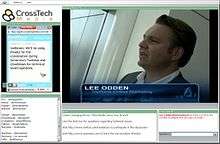Intangible good
An intangible good is a good that does not have a physical nature, as opposed to a physical good (an object). Digital goods such as downloadable music, mobile apps or virtual goods used in virtual economies are all examples of intangible goods. In an increasingly digitized world, intangible goods play a more and more important role in the economy. Virtually anything that is in a digital form and deliverable on the Internet can be considered an intangible good. In ordinary sense, an intangible good should not be confused with a service, since a good is an object, whereas a service is an activity or labor. So a haircut is a service, not an intangible good.

Definition
An intangible good is just a good that is intangible, i.e. incapable of being touched. A good is any of the following:
(A) In pure economics, a good is any object or service that increases utility, directly or indirectly.[1] According to this definition A, intangible goods include services.
(B) In macroeconomics and accounting, a good is contrasted with a service. A good is defined as an object whose consumption increases the utility of the consumer, for which the quantity demanded exceeds the quantity supplied at zero price. In the most restricted sense, some people argue all objects are physical, and the resulting definition B leaves no place for intangible goods and classifies all of them as services.
(C) In a more ordinary sense, and a middle ground between definitions A and B, an object can be intangible, and we have the definition C of good.
According to definition A, (a) a printed book, (b) a piece of music downloaded from the Internet, and (c) a haircut are all considered a good even though (b) and (c) are intangible. According to definition B, only (a) is a good and both (b) and (c) are considered to be a service. By definition C, (a) is tangible good, (b) is intangible good and (c) is a service.
Further distinction between goods and services
A different way to look at this distinction is to consider the ownership factor. If person A requests a design and person B fulfills the request and delivers the design through the Internet, the design is both a service and a digital good. It is a service that produced an intangible good. If what person A bought from person B is a service, then person A should assume ownership of the design, which is a digital good; whereas if what person A bought is considered an intangible good, then person B may still own the design. It is analogous to buying a book from a bookstore: the buyer has the right to use that book but does not own the copyright, whereas if a writer is hired to write a book for someone, then the latter will have the copyright.
References
- O'Sullivan, Arthur; Sheffrin, Steven M. (2003). Economics: Principles in Action. Upper Saddle River, New Jersey 07458: Pearson Prentice Hall. p. 3. ISBN 0-13-063085-3.CS1 maint: location (link)
Further reading
- Bannock, Graham et al.. (1997). Dictionary of Economics, Penguin Books.
- Milgate, Murray (1987), "goods and commodities," The New Palgrave: A Dictionary of Economics, v. 2, pp. 546–48. Includes historical and contemporary uses of the terms in economics.